|
On a summer visit in Hamburg I chanced upon the Hamburger
Ballett-Tage,
a yearly
festival
that
revisits
works by
John
Neumeier.
This year
falls under
the
celebrations
of
Neumeier's
50-year
jubilee as
the
renowned
choreographer
and ballet
director
prepares to
retire. His
ballet A
Streetcar
Named
Desire, created in 1983, was performed by one of only two guest companies, the Czech National Ballet, with the original costumes, sets and lighting devised, as usual, by Neumeier himself.
The ballet
is based on
the famous
1947 play
by
Tennessee
Williams
(that won
him a
Pulitzer
Prize) and
was created
twenty
years after
the
award-winning
movie
version by
Elia Kazan
with Vivian
Leigh and
Marlon
Brando.
Neumeier
created it
for the
Stuttgart
Ballet and
its superb
dancer-actors
Marcia
Haydee and
Richard
Cragun.
Neumeier's
intention
was not a
faithful
rendition,
but to
express his
personal
impression
of the play.
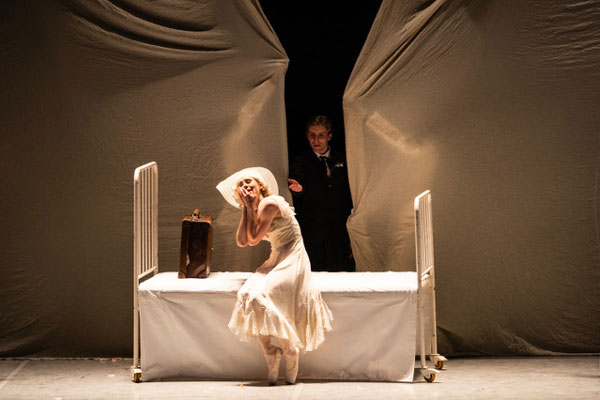
The one and a half-hour ballet is divided into two parts. Act I shows the
past of Blanche in the Confederate South, and Act II continues where the
theater play begins, with Blanche's arrival in New Orleans, at the
dilapidated flat of her sister Stella and husband Stanley Kowalski. The
opening of Neumeier's Streetcar reverses the order of the play and begins
with its end: Blanche sits on her bed in the mental hospital, dressed in the
frilly pink and white dress of her youth, with a little suitcase at her side. For
a long time she stares at the audience without any movement or sound,
giving us time to imagine the well-known drama in her memory. It's a
powerful moment that evolves into hand-wringing and nervous titters,
accompanied by Prokofiev's Visions fugitives. Soon enough, though, the
ghosts of the past, in the shape of men, appear from under the bed and the
curtains behind her. The men don't court her, they pursue her aggressively.
The suitcase falls open, a white feather boa appears, and the scene shifts to
Blanche's childhood home "Belle Rive."
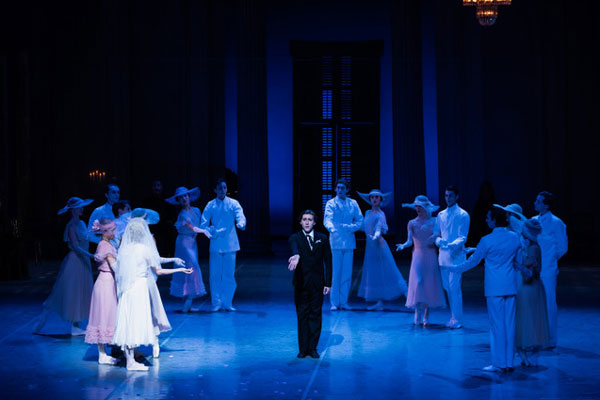
We are in the old South, indicated by louver sidings and over-head fans.
There is a party, perhaps a wedding party, with genteel couples performing
repetitive genteel dances. A bridal veil appears, then a bouquet of flowers.
Blanche dances with different men as the party goes on and on, interrupted
by sudden sounds of shots. It is unclear who is who. Is this the sister Stella
or just another bridesmaid? Is this the husband or just another suitor? The
women are all dressed in white and pink like Blanche, all identical in their
repetitive, polite cotillons. One man in black seems to be the husband, who
suddenly brings the party to life by dancing with another man. Their long
-stretched movements don't bring them close in this pas de deux, but the
notion of a broken rule keeps one's eyes glued to them. So far, the only
gravitational pull of the story lies in this brief homosexual episode. Blanche
watches their dance, angrily reprimands her man, but carries on with him
with the same conventionality as before. Suddenly, one of the shots we kept
hearing has struck him dead.
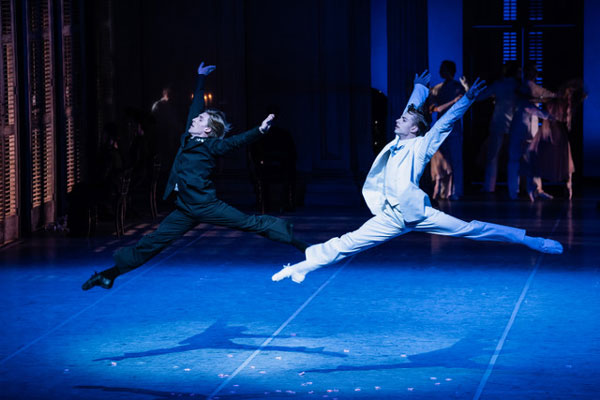
Then a group in stiff black Confederation garb, looking like ancestors, sits
stiffly at the back in a little circle and starts dying while Blanche hovers
unhappily over them. This apparently is the demise of the family. Blanche
loses her relatives and her home, symbolized by walls and roof caving in.
The party is over.
Do we care?
A main problem is that Blanche, danced by Nikola Maraova, is a pretty and
technically perfect dancer, but doesn't manage to become a character, a
person one could develop a feeling for. With the same unflattering wig, she
never appears as an innocent, vulnerable young woman who marries an
illusion and (in the play) is wrecked by guilt over her boyish husband's
suicide. The ballerina doesn't shows a development. We don't see her being
broken by her continuous illusions about one rapacious man after another,
slowly getting degraded and ostracized by a rigid society. I began to
wonder: was it only the dancer or also the choreography that failed the
complexity of the character?
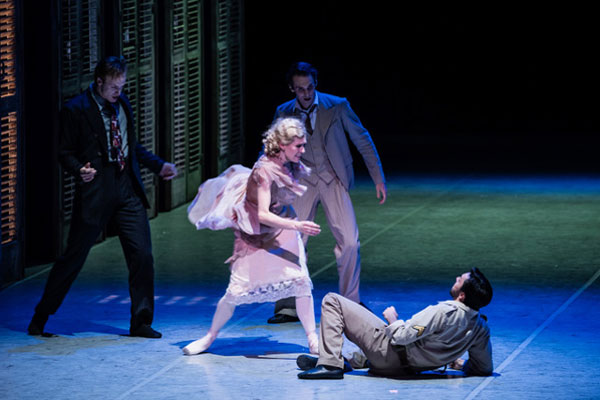
Onc can't think of Blanche du Bois and not see Vivian Leigh in Elia Kazan's
brilliant film rendition of the play. Leigh's Blanche is a woman torn up by
hysteria, self-loathing, self-pity, and violent hatred for men, all underneath
the tattered veneer of feminine wiles. What makes her so touching is her
fragile beauty and a childish hope for redemption from a cavalier in shining
armor. How would ballet – with its already exaggerated femininity –
express the outré charms of the Southern Belle that made Blanche du Bois
a favorite for transvestite shows?
In the ballet world of the early eighties, Pina Bausch and her Tanztheater
Wuppertal had already shaken up Germany with their violent body
language of extreme femininity and masculinity. The year 1983 might have
been a bit early in Germany to access the sensibility of "camp" – even for a
gay choreographer picking up the play by a gay author.
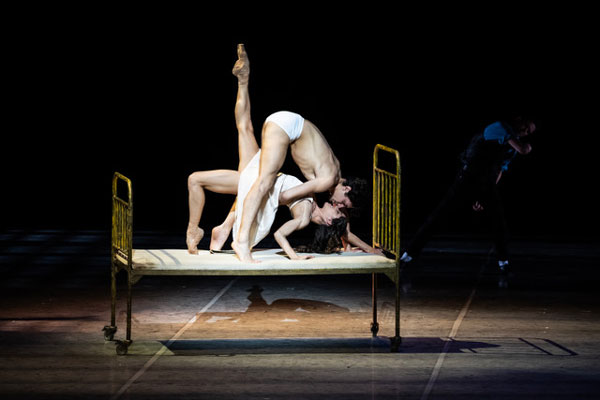
Act II begins with another bed, this time in an empty space, and we see a
couple copulating with abandon. This is Stella, Blanche's sister, and her
man, Stanley Kowalski. The music is now (and throughout the act) by
modern Russian composer Alfred Schnittke (Symphony I), a dissonant mix
of electronic sounds. Stanley is presented in unattractive underwear,
performing the usual gymnastics of what ballet does with sex. None of it is
steamy; it rather comically resembles zoo acrobatics and fails to
characterize an obsessive, sado-masochistic relationship. Danilo Lo Monaco
, in the role of Stanley Kowalski, initially comes across as a dancer without
much male charisma. But Stella, danced by Alexandra Pera, has a sensuous
aura and warm temperament that keep one's interest. She is the first
embodied "character" who shows up. Finally, the bed rolls to the side and
we are in New Orleans, where Blanche emerges with her little suitcase.
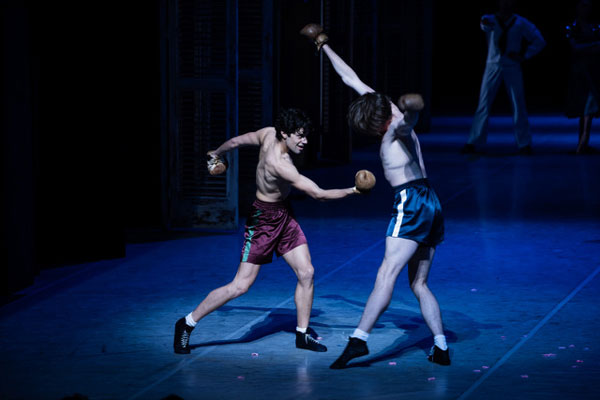
Schnittke's abstract music has some jazzy phrases, a man dances a frantic
jitterbug at the back, a few Southern types pop up or pass by, some perhaps
black, some perhaps poor, and they seem randomly strewn across the deep
stage, remaining isolated, not leaving much of a mark. Blanche gets roughly
entangled with several men, but finally meets sister Stella. I found myself
drawing a sigh of relief that we had finally reached the point where the
recognizable drama of Tennessee Williams's play would take hold.
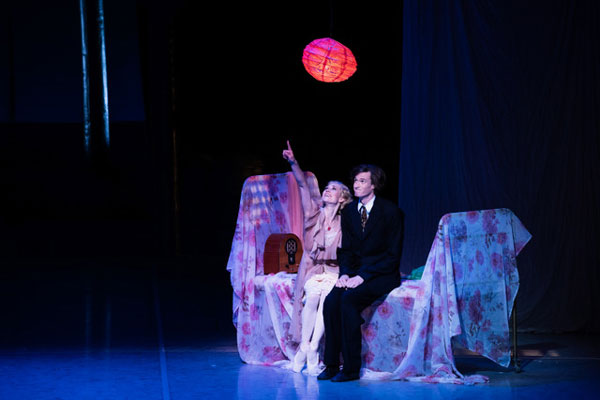
Another bed becomes the focal point of the rest of the ballet. The shabby
bed of Stella's proletarian life, soon decorated with flowery draperies by
Blanche. The relation of the sisters springs to life thanks to Stella's
presence, but all too soon Stella disappears and leaves the space to Mitch,
the fourth main character of the drama. Mitch is introduced not at a poker
round but as a sparring partner of Stanley's. Danced by John Powers, Mitch
is tall and has a brooding personality that makes him attractive and allows
some hope for tender romance for Blanche, but one feels his sexual
pressure and growing tension as Stanley interferes with obvious scorn and
aggression against Blanche.
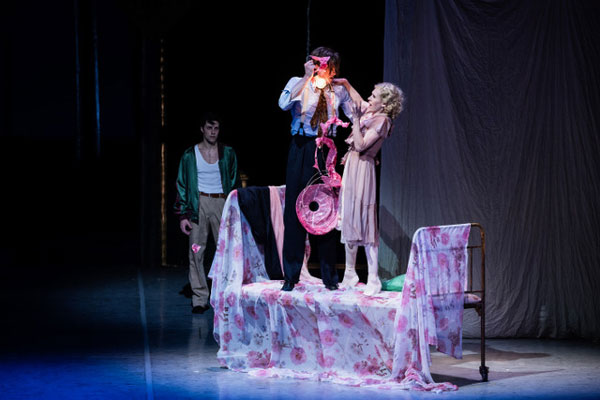
In the triangle of the two men and Blanche, the dancers suddenly seem to
pick up the dramatic suspense and urgency of the story. They slip into
character and their body language becomes compelling. Neumeier manages
to create a continuously tightening threat against Blanche who appears
more vulnerable and touching. When Mitch forces her into the glaring light
of truth, revealing her illusions of youth and innocence, it happens on that
same terrifying bed, and is violent and heartbreaking. But this is only the
start of Neumeier's endgame. It finally becomes clear what drove the
choreographer to this story – the elemental destruction of a woman
by men.
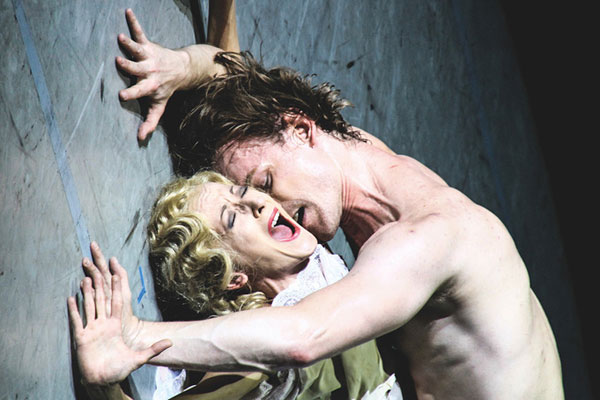
Sexual cruelty has been thematized in Neumeier's ballets with unusual
force, for example in The Little Mermaid (performed in San Francisco). In A Streetcar Named Desire it springs to life like a flame eating up a rope
toward an explosion. Now every detail, every repetition or delay seems
justified, revealing what the play and the movie didn't and couldn't show.
The sexual assault takes the form of an extended torment. Stanley's
animalistic drive now is so convincingly embodied by the dancer that he
seems to be a different person, a different beast. Blanche becomes a flailing
ragdoll under his attacks, accompanied by a dreadful cacophony of sounds
and bangs in Schnittke's score. It's the first time that the composition has a
dominant rhythm, and it's a rhythm and sound of crashing and pounding
beats. The choreography rises to extraordinary violence as the rape of
Blanche is executed like a sexual execution. Stanley stomps again and again
on her belly and between her legs as if to stamp out her sex once and
for all. It's a shocking, devastating finale, the most daring and quasi graphic
rape scene I ever saw on a ballet stage. Just as devastating is the
appearance of the doctor, a finely dressed gentleman who raises the
crumpled leftovers of Blanche from the floor with the famous "kindness of
strangers," and kisses her hand.
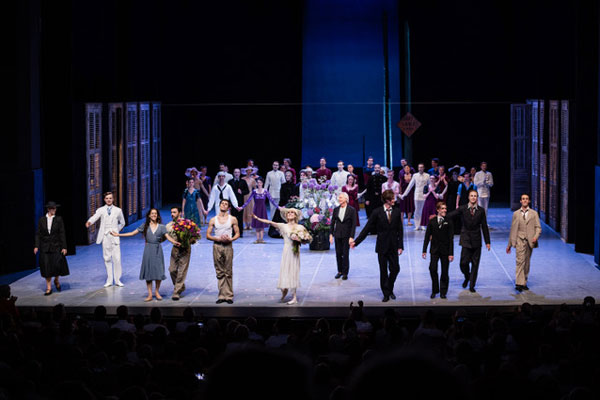
Thanks to the overpowering ending, there was strong applause. The
ballerina curtsied gratefully toward the right front of the orchestra, when
Neumeier usually sits and watches. A monstrosity of a flower bouquet was
dragged onto the stage, Neumeier stepped up and bowed with the guest
company. He looked pleased – a small, benevolent old man, surely pleased
that young dancers will continue to carry his torch.
Ideally, the performance would have been half its length and performed by
dancers who can bring a character to the stage within an instant. But this is
perhaps still to come: the 50th anniversary season begins this fall with A
Streetcar Named Desire – danced by Neumeier's illustrious dancer/actors.
It might be a different story.
Copyright Images@Kiran West
|